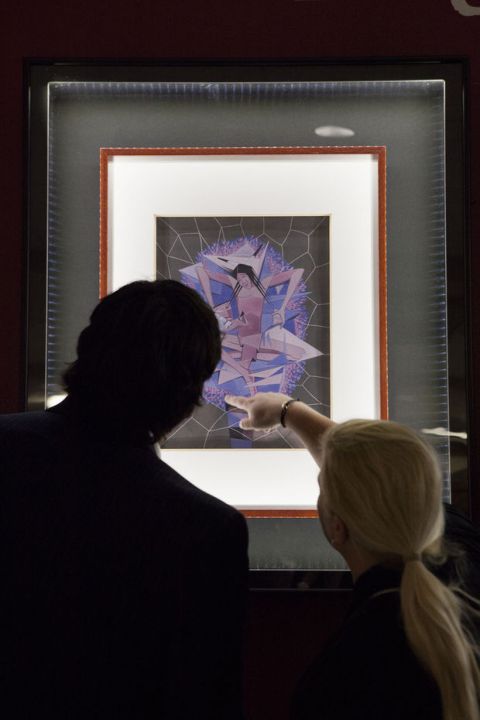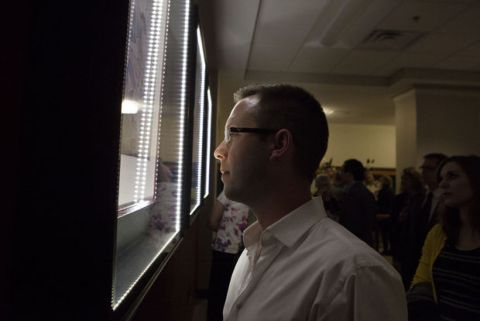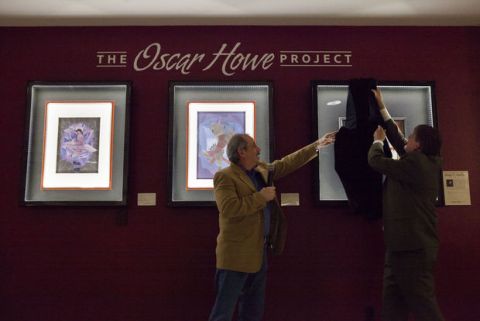 |
Canku Ota
|
 |
|
(Many Paths)
|
||
|
An Online Newsletter
Celebrating Native America
|
||
|
July 2015 - Volume 13
Number 7
|
||
|
|
||
|
Native Artist Oscar
Howe's Work To Grace Rapid City Exhibit
|
||
|
by Max B. O'Connell
- Rapid City Journal staff(
|
||
|
credits: all photos by
Josh Morgan - Journal staff
|
Rapid City celebrated one of South Dakota's greatest artists Thursday night in honor of the centennial of his birth, but also to memorialize his groundbreaking work. The 100-year birthday bash for Oscar Howe drew admirers from across the region to celebrate Howe's history and welcome a new local exhibit of his art. The night was the kickoff of the Oscar Howe Project, a new permanent exhibit at the Performing Arts Center of Rapid City and Rapid City High School Commons featuring two Howe paintings valued at an estimated $40,000. "These paintings are being exhibited in public for what we believe is the first time," said donor Byron Lee. "He was such an incredible artistic talent, so to bring two essentially new works to the public is overwhelming." The paintings, "Iktomi" and "Heyoka Dancer," were unveiled Thursday night, one day after Howe would have celebrated his 100th birthday. Both works were commissioned by Margaret Lee, mother of Byron. His stepmother, Evelyn Dawson Park Lee, served as caretaker for the paintings while they were part of the Lees' collection. Lee said the site of the event was chosen in honor of Evelyn, a former drama teacher at Rapid City High School, and Margaret, who co-founded the Black Hills Playhouse with her husband, Dr. Warren M. "Doc" Lee. "Margaret and Evelyn both loved and appreciated his work, and the arts," Lee said. "And Oscar put comedy and tragedy masks in 'Iktomi' for Margaret. I think it only right and proper that they're here." Their unveiling was commemorated and blessed by a prayer, flute composition and dance by Gerald Yellowhawk and his grandson, Stephen, as well as through brief speeches by Lee and artist Donald Montileaux. The paintings will be joined by artwork from a guest artist every month. For its inaugural period, Montileaux's "Grey Hair" is the visiting work, a great honor to the former student and friend of Howe's. "What makes him distinctive is that he combines so many influences," Montileaux said. "He loved Cubism, he loved Picasso, he loved the colors they used, and he combined that with Native culture for something wholly unique." Howe was an innovator in Native American art as well, with "Iktomi" representing a breakthrough in the use of abstraction in Indian art. In 1958 his work was rejected from a show of Native American art at Tulsa's Philbrook Museum for not being in the traditional style. Howe wrote back in protest. "He was told that his artwork was experimental, not Native American," said Lee. "And he said, 'Native American art is whatever Native Americans do.'" Howe's protest led to the adoption of abstract forms as a theme in the Native American community, though few artists can match his expressive touch. "I draw extremely well, but I and a lot of others try to do what he does and can't," Montileaux said. "We can't get the finesses. He could just elongate and shorten lines at the right places to make a hand come right at you." Montileaux joked at the ceremony, "I'd hate to be in an art show with Oscar Howe." In addition to his innovation, Howe was a big believer in paintings being more than just pictures on the canvas. "Oscar believed in telling stories and having stories behind the work," Montileaux said. "He used a lot of legends of the Native people and ceremony. He felt that was as important as the art." Lee agreed, relating how the piece "Heyoka Dancer" was a depiction of a "sacred clown," one who showed people the errors of their ways. "Iktomi," or "the spider man," meanwhile, portrays a man who tried to make others look foolish, only to make a fool of himself. These were just a few of the lessons Montileaux said he learned in the two internships he was offered under Howe at the University of South Dakota. "Two weeks with him were like a semester in college," Montileaux said. "So many people who studied at the University of Oscar, so to speak, are pursuing art because of him. He was my mentor and my hero, truly." Howe taught as a professor of the arts at USD from 1957 to 1980. He died in 1983 after a prolonged illness. Howe's work will continue to teach, however. The Oscar Howe Project will be used to teach all grades from K through 12, with plans underway to create lessons aligning state literacy standards with the Oceti Sakowin Project's standards for teaching the rich Lakota culture. Lee said that whether it was as a part of a lesson plan or a permanent part of the school, he hoped it would inspire students. "I hope they take pride in the incredible mythology that is the Dakota myth," Lee said. "And that they see Howe's work and realize that a person of great skill and talent can become respected and famous no matter where they're from. |
|||||||||||||||||
|
|
||
|
|
||
| Canku Ota is a free Newsletter celebrating Native America, its traditions and accomplishments . We do not provide subscriber or visitor names to anyone. Some articles presented in Canku Ota may contain copyright material. We have received appropriate permissions for republishing any articles. Material appearing here is distributed without profit or monetary gain to those who have expressed an interest. This is in accordance with Title 17 U.S.C. Section 107. | ||
|
Canku Ota is a copyright ©
2000 - 2015 of Vicki Williams Barry and Paul Barry.
|
||
 |
 |
|
|
The "Canku
Ota - A Newsletter Celebrating Native America" web site and
its design is the
|
||
|
Copyright ©
1999 - 2015 of Paul C. Barry.
|
||
|
All Rights Reserved.
|
||





